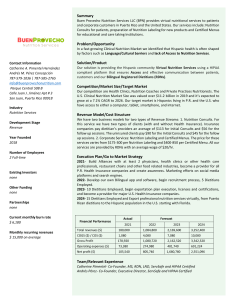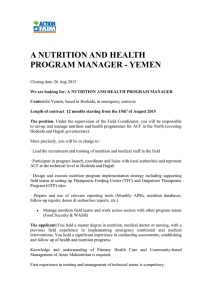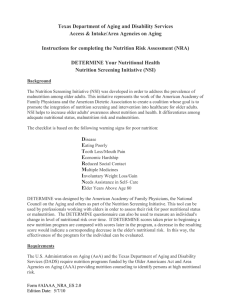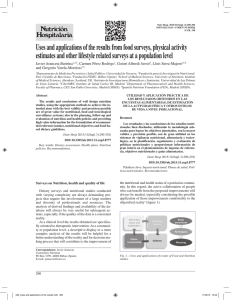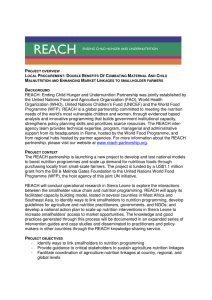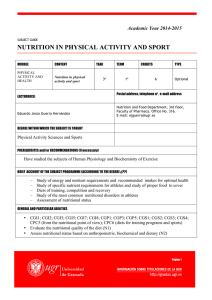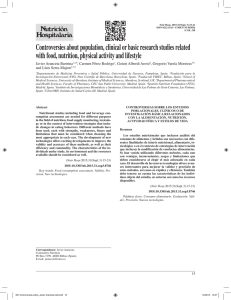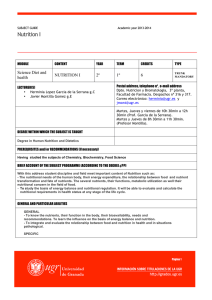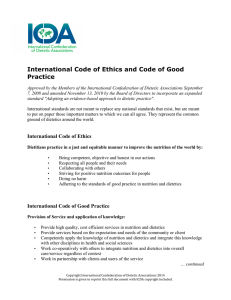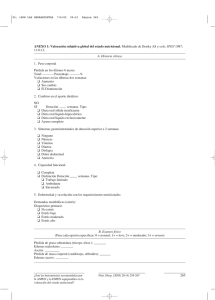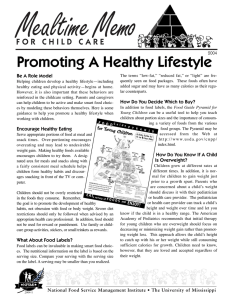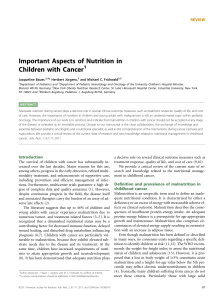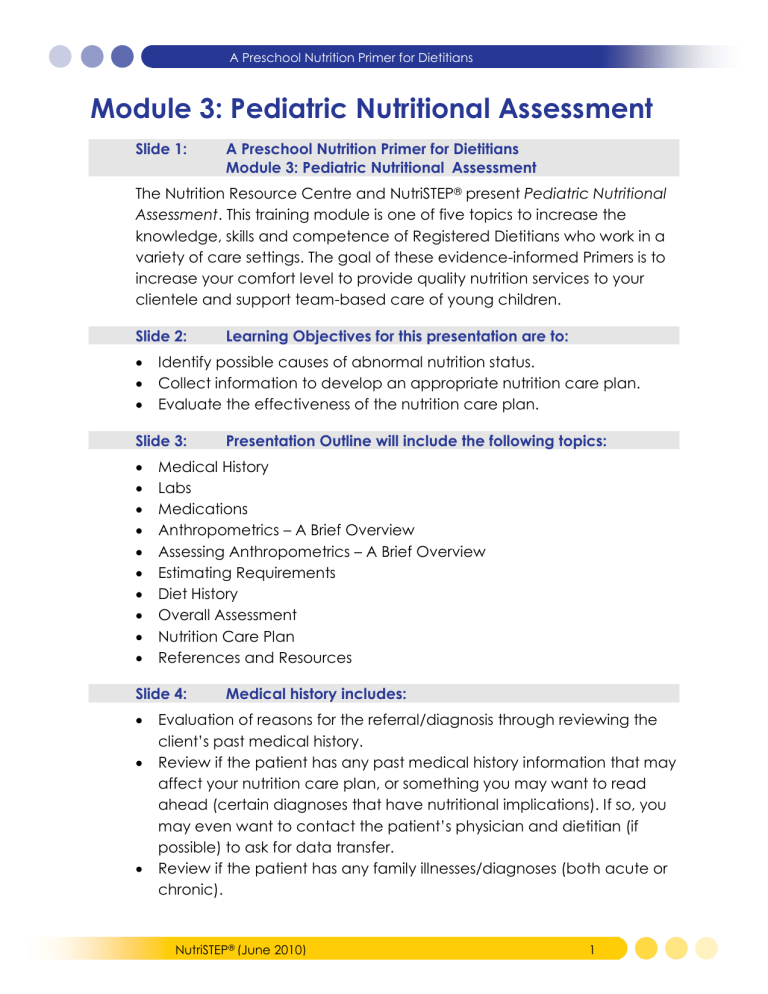
A Preschool Nutrition Primer for Dietitians Module 3: Pediatric Nutritional Assessment Slide 1: A Preschool Nutrition Primer for Dietitians Module 3: Pediatric Nutritional Assessment The Nutrition Resource Centre and NutriSTEP® present Pediatric Nutritional Assessment. This training module is one of five topics to increase the knowledge, skills and competence of Registered Dietitians who work in a variety of care settings. The goal of these evidence-informed Primers is to increase your comfort level to provide quality nutrition services to your clientele and support team-based care of young children. Slide 2: Identify possible causes of abnormal nutrition status. Collect information to develop an appropriate nutrition care plan. Evaluate the effectiveness of the nutrition care plan. Slide 3: Presentation Outline will include the following topics: Medical History Labs Medications Anthropometrics – A Brief Overview Assessing Anthropometrics – A Brief Overview Estimating Requirements Diet History Overall Assessment Nutrition Care Plan References and Resources Slide 4: Learning Objectives for this presentation are to: Medical history includes: Evaluation of reasons for the referral/diagnosis through reviewing the client’s past medical history. Review if the patient has any past medical history information that may affect your nutrition care plan, or something you may want to read ahead (certain diagnoses that have nutritional implications). If so, you may even want to contact the patient’s physician and dietitian (if possible) to ask for data transfer. Review if the patient has any family illnesses/diagnoses (both acute or chronic). NutriSTEP® (June 2010) 1 Module 3: Pediatric Nutritional Assessment Growth history, which is usually a challenge to obtain as family doctors/pediatricians may or may not document weights and lengths/height every visit. Ask for a growth chart if possible, if not, ask for anthropometric measurements and plot onto an appropriate growth chart. Obtaining growth history can be extremely valuable in determining how the patient is growing, identify if there are any growth issues (current and/or previous), use information to help with calculating BMI and IBW and identify if the patient is over- or underweight. Slide 5: Standard lab work includes: Complete blood count Electrolytes Glucose Blood urea nitrogen & Creatinine Albumin Calcium, phosphorus, magnesium Ferritin And other pertinent tests or investigations (such as sweat chloride for those failure to thrive or malabsorption issues to follow up cystic fibrosis) Keep in mind that reference ranges in serum levels of these tests do vary between adults and children. Additionally, consider medications that the patient may be on that may affect electrolytes and etc. Slide 6: Pertinent medications to consider include: Vitamin and/or mineral supplements Antisecretory Antiemetic or upper GI motility Antibiotics Diuretics and etc. Keep in mind the doses, is it permanent or temporary, reasons for medications, and nutritional implications (such as electrolytes, hyper or hypo-metabolic). Slide 7: 2 Anthropometic measurements include: NutriSTEP® (June 2010) A Preschool Nutrition Primer for Dietitians Weight Standing Height Other measurements including: o Head circumference (up to the age of less than 36 months) and o Skin-folds See Growth Assessment Part I for more detail on how to perform these measurements with appropriate equipment and growth charts. Note for preschoolers, head circumference is no longer done. Mid-arm circumference and skin folds are not routine measurements. Slide 8: Weight Weight is a good indication of acute nutritional status. However, having one value and plotting on the growth curve is not a good enough indicator for long term nutritional status. As dietitians, we need to look at the trends (if possible). It may be beneficial if a family physician may have access to that information. If not, ask the parents about the weight history (even though it may or may not be accurate). In this situation, need to look at the “big picture” and consider the rest of the assessment (i.e. food intake, difficulties with food intake, other anthropometrics, social, etc). There will likely need to be a follow up visit to assess growth and nutrition adequacy and so you can track any weight changes and the impact of the nutritional plan. Keep in mind that toddlers and older children/teens should be weighed with minimal clothing on a standing scale to 0.1 kg. Those with special needs may need a lift scale or wheelchair scale. Slide 9: Weight Velocity Even though we’re looking at children aged 3-5, we have to consider the big picture of growth from infancy to adolescence. When considering weight velocity, an infant generally: Regains birth weight by 10-14 days old, Doubles by 4-6 months, and Triples by 12 months of age Infancy (between 0-12 months) is the most rapid period of weight gain Adolescence is the second most rapid period of weight gain NutriSTEP® (June 2010) 3 Module 3: Pediatric Nutritional Assessment Preschool age is a period of steady and static growth; rarely do they have a growth spurt unexpectedly. Don’t expect to see significant changes in weight and height gains in a short time period with this age group as it may take a number of months to see normal growth changes. Doing growth measurements in 1-3 months time may be unreasonable unless significant changes are made in the care plan and child was significantly over or underweight. Look for short term changes in behaviours rather than growth factors. Reassure parents and child this is normal and expected. Slide 10: Standing height is: Use when over the age of 2 If the child is unable to stand, use recumbent length or knee height to determine height Use calibrated stadiometer and Measure to 0.1 cm We have to consider parental height and Chronic illness or special health care needs See Growth Assessment Part I for more information and health professional guidelines re: proper equipment and technique. Slide 11-12: Standing Height The illustration on this slide and the next slide demonstrates proper technique in measuring standing height. You may need to check your measurement 2 or 3 times to ensure it is correct. Slide 13: Know growth chart options such as age and sex appropriate, CDC vs WHO charts Determine and calculate child’s age in years and months Choose an appropriate growth chart Plot all indices including weight for length or BMI Classify stunting or wasting, and Classify overweight or obesity Slide 14: When assessing anthropometrics: There are several growth chart options: The CDC charts (with growth curves from the 3rd to the 97th percentile) were developed in 2000. 4 NutriSTEP® (June 2010) A Preschool Nutrition Primer for Dietitians They were approved for use in Canada in 2004. The National Growth Monitoring Position can be found on the Dietitians of Canada website. Special charts are available, such as Down’s Syndrome, and others. The World Health Organization growth references were new as of April 2006. And are now considered as the NEW standard – the collaborative statement can also be found on the Dietitians of Canada website. Slide 15: Are new global Child Growth Standards for infants and children up to the age of five. Standards are based on 8,440 breastfed children internationally as the norm for growth and development. These growth charts show how children should grow. It also detects children or populations not growing properly or under/overweight and may require specific medical or public health responses. Slide 16: The WHO Growth Charts: To determine and calculate age: You can estimate age to nearest 1/4 year or by Decimal Age (which is generally used for children > 2yrs old). For Decimal Age, you would take today's decimal date and minus the birth decimal date. This converts annual age into a decimal for precision in plotting. In order to determine the decimal date, you will need the decimal age table (which can be found on some growth charts). Slide 17: To determine and calculate age (continued): Another method is to determine the child’s age in years and months and plot accordingly. For example, a child who is 4 ½ years old is 54 months old. It is not as critical when plotting older children re: decimal age but ensure that the child is plotted in the right year and quarter for their age. Slide 18: Choosing the appropriate growth chart Note there are CDC growth charts for boys and girls and for children birth to 36 months and 2 to 20 years. Boys’ charts are blue and girls are pink. NutriSTEP® (June 2010) 5 Module 3: Pediatric Nutritional Assessment Slide 19: Plot All Indices For infants age 0 to 36 months, you need to plot weight, length, head circumference and weight for length while for children age 2 to 20 you need to plot weight, height and BMI. Slide 20: This is a sample plot of a 12-month old boy. Slides 21 and 22: This is a sample plot of a 16-year old female including BMI. Slide 23: Classify Once the plotting on the growth curves is complete, the next step is to determine if a client is classified as normal weight, stunted/wasting/underweight, or overweight/obese. Slide 24: CDC Classifications The CDC growth curves have a set of classifications of nutritional indicators based on one’s anthropometric cut-off values. Examples are indicated below. Slide 25: Ideal Body Weight Many dietitians use different methods for calculating Ideal Body Weight depending on what is most appropriate for their populations, and are different from each other. The important thing is the consistency of your choice of method for calculating ideal body weight. Some methods include: Weight at the same percentile as the child’s height percentile (Moore Method), Weight for length at the 50th percentile, BMI at the 50th percentile, or “Standard Weight” or McLaren Method (weight at the 50th percentile for height age). The Percentage of ideal Body Weight is calculated by actual weight times 100, divided by ideal body weight. 6 NutriSTEP® (June 2010) A Preschool Nutrition Primer for Dietitians Slide 26: Weight Age and Height Age To determine weight age on the growth chart, you would plot the age at which the current weight hits the 50th percentile. To determine height age on the growth chart, you would plot the age at which the current height hits the 50th percentile. Slide 27: Growth Chart This diagram is a 0 to 36-month male growth chart with an example of how to determine weight age and height age. Slide 28: Growth Chart (continued) This diagram is a 2 to 20-years male growth chart with an example of how to determine ideal body weight using body mass index. Slide 29: Nutritional Status Classifications The chart below presents examples of nutritional status classifications based on one’s anthropometric measures and where one plots. Slide 30: Risk of Malnutrition can be classified as: Wasting/underweight o Impairment of cognitive development (verbal, spatial and scholastic ability) o Aggressive, hyperactive o Externalizing problems, conduct disorders o Excessive motor activity Overweight and obesity o Weight related chronic diseases such as cardiovascular disease or diabetes o Respiratory and joint problems o Self-esteem, body image concerns Slide 31: Estimating Requirements Estimating requirements include: Energy Protein Fluid Micronutrients NutriSTEP® (June 2010) 7 Module 3: Pediatric Nutritional Assessment Slide 32: Energy Requirements There are many different ways of estimating energy requirements, such as using: The Recommended Nutrient Intake The WHO equations Basal Metabolic Rate Kcal/cm And Catch-up growth The BEST way is to take regular measurements of growth and energy intake. Some dietitians use recommended nutrient intakes for calorie and protein requirements, but dietary reference intakes for everything else. You can ask 10 different dietitians what they do, and you will get 10 different answers. However, despite different methods, when you consider their 10 different estimates, they will all be within pretty close range. So pick 1 or 2 that work for you and just be consistent with it. It is after all only an estimate, and then upon reassessment of intake and weight gain the "needs" are really determined. For the micronutrients on the other hand, dietary reference intakes are now used. Slide 33: Recommended nutrient intakes are Based on age and gender (after age 7) And expressed as calories per kilogram weight It assumes normal activity and no extra stressors For example: o If < 90% of ideal body weight: use ideal body weight or catch up growth in the calculation o If between 90 and 110 % of ideal body weight: use actual weight o If >110 % of ideal body weight: use ideal body weight in the calculation The equation for estimate energy requirement is weight times recommended nutrient intakes (based on calories for age and gender). Slide 34: The Recommended Nutrient Intakes chart below shows: Energy needs expressed as calories per kilogram weight per day in relation to age. It ranges from 0 to 3 years of age, and these recommendations are based on term infants. 8 NutriSTEP® (June 2010) A Preschool Nutrition Primer for Dietitians Slide 35: Basal Metabolic Rate is For children > 1 year old It is used when metabolic demands are increased, such as trauma, respiratory issues, surgery, and etc It is also used when activity level is increased or decreased It may be used in children with developmental disabilities The WHO equations are similar to this Slide 36: The Basal Metabolic Rate Chart below shows: Energy needs expressed as calories per kilogram weight per day in relation to age and sex. It ranges from 1 to 20 years of age. Slide 37: Basal Metabolic Rate Factors Chart below shows: Activity and stress factors that are applied based on the child’s individual situation. Slide 38: Used for children with special needs And who are between the ages of 5 and 12 years old Slide 39: Calories per centimetre is: Catch-up Growth: May be used when a child is < 90% of his or her ideal body weight (such as wasting/underweight) Ideally, we want 1.5-2 times the rate of normal weight gain Catch-up growth equation is expressed as recommended nutrient intake per kilogram weight gain per day for weight age multiplied by the ideal body weight for age, then divided by the actual weight. Slide 40: Estimating Protein Requirements: Protein is required for synthesis of new body tissue during periods of growth. As such, there are high needs per kilogram of weight during infancy, childhood and adolescence. Additional protein is not needed for catch up growth. It is based on actual weight. Protein recommendations are based on the Dietary Reference Intakes, and are used for relatively healthy children. NutriSTEP® (June 2010) 9 Module 3: Pediatric Nutritional Assessment For children aged 1-3 years, protein recommendation is 1.05 grams per kilogram weight per day. For children aged 4-8 years, protein recommendation is 0.9 grams per kilogram weight per day. For the abovementioned age groups, the protein recommendations are the same for both males and females. Slide 41: For body weight 1-10 kilograms, it is 100 millitres per kilogram weight per day For body weight 11-20 kilograms, it is 1000 millitres + 50 millitres per kilogram weight for each kilogram above 10 kilgrams For body weight >20 kilograms, it is 1500 millitres + 20 millitres per kilgram weight for each kilogram above 20 kilograms `Slide 42: Micronutrient Requirements Are based on age and gender And are based on the Dietary Reference Intake tables. Is it recommended that infants and children receive micronutrients from foods Consider supplementation only when there is: o Poor oral intake o Clinical deficiencies such as iron o Increased losses (such as Cystic Fibrosis), or o Restrictive diets (such as Vegan) Slide 43: Fluid Requirements (or Maintenance Fluids) are based on body weight: Diet History The purpose of obtaining a diet history is to estimate total energy and protein intake, and identify anything lacking, excessive or abnormal. You will need to be familiar with normal pediatric nutrition by reviewing: o The Health Canada Nutrition For Healthy Term Infants, o Eating Well with Canada’s Food Guide, and o Dietitians of Canada Healthy Start for Life You can use 24-hour recall or 3-day intake records. See nutrition assessment tool and 3- day food intake record samples that can be used in your practice. 10 NutriSTEP® (June 2010) A Preschool Nutrition Primer for Dietitians Slide 44: Age and presenting problem o Feeding history from birth such as: o Breast vs bottle feeding o Introduction to solids, and o Any feeding aversions/difficulties Feeding milestones Look at the full 24-hour day (including intake during the night, such as bottle feeding) Eating routine/schedule Allergies, intolerances, avoidances Slide 45: Social Questions to consider are: What time do they eat, where, with whom? Family eating habits, routine Daycare or other caregivers Behaviors at meals, and Food security Slide 47: More key questions to consider are: Stools characteristics (such as frequency, color, texture) Urine output (such as frequency) Emesis For children and adolescents, consider: o Body image o Substance abuse o Lifestyle/activities, and o Eating routines/habits Slide 46: Some Key Questions when obtaining a diet history are: In the Overall Assessment: Summarize pertinent points from the medical history, medications and lab work State findings of anthropometric assessment (e.g. stunting, wasting, obesity) State estimate of nutrient requirements Describe pertinent findings from diet history (e.g. meeting CFG or energy/protein/fluid needs), and Describe any social issues related to nutrition NutriSTEP® (June 2010) 11 Module 3: Pediatric Nutritional Assessment Slide 48: It is developed with parent involvement (and child if appropriate) To set nutrition goals The dietitian makes recommendations to meet those goals, including: o Oral/enteral/parenteral nutrition and o Vitamin/mineral supplements The dietitian may request further testing (such as lab work, swallow/feeding study) Then plan to reassess, re-evaluate and revise Slide 49: In the Nutrition Care Plan: The Follow-Up Plan: Reassess anthropometrics Document changes in the nutrition care plan Were recommendations followed? Collection of 3-day food record (if suggested from the previous visit) Reassess and continue with previous plan or implement a new nutrition care plan Slide 50: This is the end of the presentation. There are practice questions that can be completed on your own time, and are not part of the audio presentation. The questions and correct answers are located in the separate link titled Modules 1-5: Case Study Questions and Answers. Slide 51: No voice recording. 12 NutriSTEP® (June 2010)
